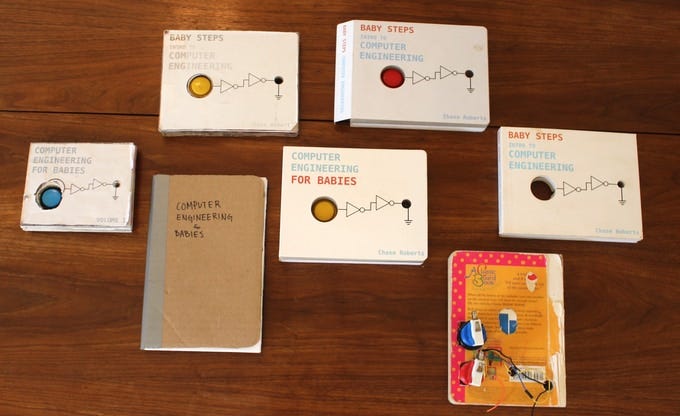An Interview with Chase Roberts
Author of Computer Engineering for Babies
The Idea
While watching his one-year-old son years ago, Chase Roberts noticed his fascination with light switches. This gave Roberts an idea to build something for his son to explore that curiosity and maybe even learn something.. He grabbed an old children’s book, cut some holes in it, then added buttons and a circuit board. Thus the first prototype of the book, Computer Engineering for Babies, was created. With a successful Kickstarter campaign under his belt and 10,000 copies of the book on the way, there was clearly a long road between that first ripped up children’s’ book and what the project has evolved into. I got to interview Roberts about the book and the efforts that went into making it.
With an education in engineering and a career in software, Roberts has always loved the idea of teaching these topics to kids. What Roberts ultimately set out to do, however, was create an interactive book for kids that’s fun, with buttons and lights to cause a reaction. Roberts didn’t expect babies to truly grasp the concepts in the book, but rather become engaged and curious with them. The current version of the book has six pages, each with a different fundamental engineering function (making it a learning tool for parents as well).
The Process
As with most hardware products, the first couple designs were far from what Chase envisioned as a final product. There have been multiple prototypes since that first cut-up children's book, which according to Roberts, was a good start but only “kind of worked.” Roberts admits that his project has included much “flying by the seat of my pants” and “learning the hard way what doesn’t work”. Along with needing to make something that worked, the book would also need to to be appealing to customers looking for a children’s book. The aesthetic components of most products are often not overseen by the engineers who built them. However, as Roberts was the only one working on his book he had to take those responsibilities on himself. With the physical book almost completed the programming required to bring everything together was the next task.
Evolution of book prototypes
Having studied a technical engineering discipline in college and then becoming an app developer gave Roberts a unique skill set of both hardware and software knowledge. This knowledge allowed Roberts to find unique solutions for every problem that arose. Hardware and software was used to troubleshoot issues like the wrong sensors being activated with too much light coming through the pages, wiring problems, and even needing to accommodate for manufacturer limitations such as switching microcontrollers or materials.
On top of creating a working model, a manufacturer willing to produce them became the next hurdle. Almost every engineer (especially with the current supply chain issues) has run into problems when finding a manufacturer. This was even more difficult for Roberts as his product was a book mixed with electronic parts, something not made every day. Although a manufacturer was found, Roberts still tinkered with materials to decrease production cost. This even included changing microcontrollers, or the “brains” behind the electronics in the book.
After this grueling design process, it was only fitting that the book would go viral after its release. Roberts launched a Kickstarter campaign with the thought of just selling enough to keep making more and to see his project through to the end. Roberts stated that his biggest worry about the campaign was that it wouldn’t resonate with people, and he would end up with a garage full of children's books. However, Roberts soon realized that this would not be the case.
“Computer Engineering for Babies” Goes Viral
After the campaign was launched it immediately found an audience, and once it was picked up by Reddit and other social media platforms, it went viral. “I just wanted to see the project through to the end because I’d been working on it for so long,” Roberts said. “I just got super lucky. It took off and funded on the first day, which was awesome, and it just kept going from there. I just happened to have an idea that people liked.” As the campaign gained traction, posts about it exploded on Linkedin, Twitter, Facebook, and more; sometimes accounting for thousands of dollars in sales.
With the product in a form that works and is loved by customers, Roberts still handles preorders, sales, and technical issues as needed. He would like to pursue the project full time and is excited to be working with hardware again, where many of his interests and education lie. Next on deck for Roberts is to introduce more advanced concepts in the next revision and possibly create more products that can teach engineering and technology .
As the books’ notoriety and sales continue to grow, Roberts doesn’t plan to stop building any time soon. “I love to build stuff,” Roberts said. “If selling books enables building, I’ll keep doing that.” For more information, visit the books’ website or the Kickstarter Page
The current version of “Computer Engineering for Babies”




